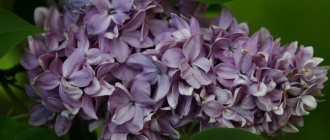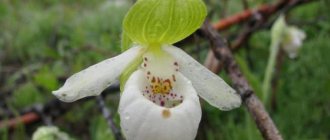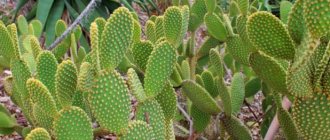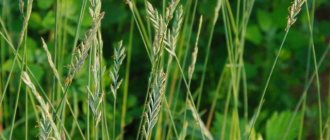What types of lupins are there, when to plant them, what kind of soil this plant prefers, is it possible to grow them from seeds - let’s take a closer look. The beauty of these flowers inevitably attracts the eye and makes you want to plant them in your garden. The variety of colors is amazing; they can be white, yellow, red, pink, blue, dark red and even tricolor. They look great in company with other garden flowers and decorate flower beds, paths, and alpine slides.
In addition to the aesthetic effect, these plants improve the structure of the soil and enrich it with nitrogen. With all this, these flowers are not at all capricious; the process of growing them and caring for them will not cause you much trouble.
When do lupins bloom? This time comes with the arrival of calendar summer - in June, and lasts about a month. It is noteworthy that perennial representatives can produce color twice per season - in the second half of July and then in August.
There are approximately 200 species of this decorative flower, all of them are similar to each other (candle shape, leaves look like palm trees), and have minor differences in the structure of the inflorescences.
Leaf after the rain
Lupine is a plant from the legume family, can be either annual or perennial, has thick, long roots that reach about 2 meters deep. In addition to the work of the roots, the above-ground part also makes its contribution to enriching the soil. It is cut off and buried in the ground to a depth of about 20 cm, where it safely rots, thereby releasing useful substances into the soil and reducing acidity.
For all its decorative qualities, this plant is a forage and green manure crop.
Inflorescences and leaves, photo:
Lupine as green manure and fertilizer
The grains, as well as the green part of the plant, are very rich in protein (40-50%), while at the same time the production of toxic bitter alkaloids is also high. According to the content of toxic substances in their composition, lupins are bitter, low-alkaloid, and sweet. Bitter varieties are used to fertilize the soil, but sweet and low-alkaloid varieties can be used as animal feed. This plant crop is very productive; white, yellow, and blue lupines (also called narrow-leaved lupine) are grown to obtain feed raw materials. Fertilizers are most often sown with perennial crops.
White lupine can reach a height of one and a half meters and tolerates drought comfortably - this is the most common variety.
Flowers of this species can be white, pale pink, pale blue. This is the best green manure for poor soil with a high level of acidity (deoxidizes it). It grows well and gains green mass even on infertile soil. Recommended for sowing on loam and sandy loam soils - it increases their fertility and can completely replace manure. The white roots are inhabited by bacteria beneficial to the soil; they convert poorly soluble phosphates into accessible forms. After removing the above-ground part of the plant (cutting), the roots decompose in the soil, turning into an easily digestible fertilizer. As a result, the soil is enriched with humus and organic components.
Yellow lupine is also an excellent green manure, it heals the soil, improves its structure, and increases fertility without any chemical influences. This crop is simply a record holder for saturating the soil with nitrogen; after its presence, 200-250 kg of nitrogen/ha remains on the field in the most acceptable form for future plantings. Yellow is sown quite early, and when it has formed beans, it is time to mow.
Lupine, as a green manure, not only nourishes the soil, but also loosens it quite well. As already mentioned, this plant has a developed, powerful root system. The roots branch in different directions - thus, the earth is loosened, the mineral compounds of the soil rise to the upper layers. This culture increases the drainage properties of the soil and promotes its reclamation. After sowing this crop, the soil retains moisture and air better. This plant also serves as a source of food for earthworms, which helps increase productivity and resistance to disease in the future.
The advantages of this plant as green manure:
- Long roots going deep into the soil, extracting useful elements from its depths;
- The ability to assimilate and process heavy micro- and macroelements of soil;
- Abundant yield, usefulness comparable to manure;
- Rapid maturation - the plant reaches the required condition 45-50 days after sowing the seeds.
Are lupins poisonous or not? As feed for farm animals, it acts as a source of ideal, easily digestible protein. This is the best option of all leguminous crops available today. The stems and foliage of the plant contain many useful components; the grains are a source of fat.
The disadvantage of this situation is the presence of toxic alkaloids in the plant.
For feeding animals, only yellow or white lupins should be used - they contain the least amount of toxic substances.
The blue species cannot be used as a forage crop. Usually the green part of the plant is used for feed mixed with other ingredients: silage, dung, artificial feed.
To prepare fodder and hay, the plant is cut at the stage of bud formation. Yellow lupine is mowed before the onset of the bean formation phase, white - without waiting for the end of its flowering.
Blue view, photo:
In field
Care technology
Growing lupine is not difficult, but requires following basic care recommendations:
- for perennial and annual lupine it is necessary to periodically loosen the soil on the site and regularly remove weeds;
- when caring for adult plants, it is necessary to carry out systematic hilling, which will protect the gradually exposed root collar of the ornamental crop from the negative effects of unfavorable external factors;
- old plants that are more than five years old are recommended to be removed and replaced with young specimens, due to the death of the central part and a noticeable deterioration in flowering;
- when growing tall varieties and hybrid forms, it is necessary to use supports, which is especially important in areas with strong and gusty winds;
- In order to extend the flowering period, experienced flower growers recommend timely pruning of faded and wilted inflorescences, since in the future all the plant’s energy will be spent on the formation of seeds;
- irrigation measures at all stages of lupine growth and development should be moderate but regular;
- if necessary, during the dry spring and autumn periods, plants should be provided with abundant moisture-recharging watering;
- starting from the second year of life, plants need mineral fertilizers with the addition of nitrogen, which are fertilized in early spring;
- For each meter of flower bed, about 15-20 g of superphosphate and 3-5 g of calcium chloride should be added;
- In winter, it is advisable to insulate the soil around the plant with sawdust, which is especially important when growing ornamental crops in northern latitudes, as well as in areas with little snow and very frosty winters.
Prevention of diseases and pest damage should not be neglected. At the stage of bud formation, lupins are often affected by aphids. During the active flowering phase, the maximum damage to a flowering crop can be caused by the larvae of the germ fly and root nodule weevils, protection against which involves the use of the most effective and modern insecticides. Lupines also need to be prevented from being affected by gray or root rot, fusarium wilt, spotting, mosaic and rust.
Perennial lupins - planting and care
This is a truly unpretentious plant that does not require any special growing technology. The most important thing is to know what kind of soil lupine prefers, as well as the period for planting it.
This flower feels equally good in shady or sunny places. If you want to achieve the highest levels of decorativeness, then place it in a shaded area of the site.
It loves slightly alkaline, non-acidic soil; with high acidity it will grow very frail, and in alkaline soils it can develop chlorosis. This situation can be changed if you first add dolomite flour (or lime acid) to the soil.
Perennial lupine is sown after the snow melts, around April. The plot of land on which the flowers will grow should be prepared in the fall. Before sowing, it is recommended to treat the seeds with foundationazole (50% solution). With this approach, you will be able to see the first flowers after 12-13 months (they usually bloom by May).
Seeds (beans), photo:
To obtain lupine seeds, several pods should be left on the plant, which will dry, ripen and provide the necessary seed material. During flowering, faded inflorescences are usually removed - this is necessary so that the growth of new flowers is not inhibited and self-seeding does not occur.
Leave a few inflorescences until they ripen completely (preferably in August); if you don’t have lupins yet, you can always buy the seeds at flower shops. The pod must be completely dry (no moisture allowed), and the extracted beans should also be thoroughly dried. It is best to store seed material in a glass container or in fabric or paper bags.
Pods, photo:
An unusual way to grow lupine
In autumn, you can scatter lupine seeds under the trees. This flower takes root well near apple, cherry, plum and other fruit trees.
After winter, in spring you will see a whole garden of lupines. Seeds of different colors are best suited for this. Then you will receive colorful and bright flowers in April.
Lupine propagation - different options
If you are going to plant these flowers in your dacha, then know that annual lupine can only be propagated using seeds. Perennial species are available for propagation by seeds and cuttings.
Propagation of perennial lupine by cuttings
A cutting is a growth bud that is located on a rosette of leaves at the base of the plant. With the arrival of spring, these buds are carefully cut off and then rooted in open ground (choose a shaded area). At the planting site, it is very advisable to dilute the soil with sand to make it lighter. Another option is to select young shoots from the leaf axils after the plant has already flowered.
This planting source is rooted in the soil in the same way; the process of adaptation and establishment of the plant in a new place lasts approximately 35-40 days. After this time, the rooted seedlings can be transferred to flower beds, alpine hills, and flower beds. The main thing is not to exceed the recommended period so that the plant does not have time to take root thoroughly and take root. Lupine roots react extremely negatively to any intervention, so replanting will not lead to anything good. For the same reason, this flower is not propagated by dividing the bush.
Lupins from seeds - growing
First of all, you need to decide on the sowing time: it can be autumn or spring. Frost-resistant, self-seeding representatives of this crop are preferably planted in the fall. Around November, when the first frosts have already occurred, the seeds are buried a little (about 2-3 cm) into the soil and covered with a thin layer of peat. The distance between future bushes should be approximately 15 cm. Thus, with the arrival of spring you will see young growth, and by the end of summer it will give color. If you decide to plant plants in the spring, then choose the first weeks of April. Then, with the arrival of next spring, you will be able to admire the diversity of these beautiful flowers.
Shoots
Young bushes
Lupins, photo:
Advice - for the best result, hard lupine seeds should be first scarified (slightly damage the top layer). To do this, experienced gardeners use one of the techniques described below:
- Scratch the bean shell mechanically - rub it with sandpaper or lightly cut it with a sharp object. During these steps, make sure that the inside of the seed is not damaged. After scarification, the seed should be soaked for several hours (so that it swells).
- Immerse the seeds in a temperature shock (sharp change in temperature) - place the beans in a clean thin cloth, then freeze them in the freezer. After removing them from the freezer, they should immediately be immersed in boiling water, briefly. Due to such a temperature contrast, the shell of the beans will crack, and the desired effect will be achieved.
- A bath of a chemical solution is a ten-hour soaking of seeds in a solution of bleach (10%) or potassium permanganate for 15-20 minutes. You need to take 2 or 3 drops of chlorine solution per glass of water. After exposure, the seed should be thoroughly rinsed with cold water. This method of scarification has an additional antibacterial effect if there is a threat of plant damage by fungi or other diseases.
Then we proceed to the next stage - lupins from seeds, growing in containers. To do this, pour soil into pre-prepared cassettes, disposable cups or separate plastic containers. Don't forget about the presence of drainage holes at the bottom!
The soil for these plants should include peat, turf, and clean river sand. It would not be superfluous to first disinfect it by frying it in the oven or microwave; scalding with boiling water is also suitable. Be that as it may, the soil for seedlings should be light.
Fill the pots with this soil, press it down a little, and water it with water at room temperature. After that, put the beans on top, deepen them a little, and water again (it’s better to use a spray bottle). Next, cover the containers with plastic wrap and take them to a place where it is warm and light.
We carefully monitor the level of soil moisture, water if necessary, and promptly remove condensation. The first sprouts should appear after about 2 weeks. At this stage, the film should not be removed yet; you can only water it daily and ventilate the sprouts (not for long). It will be possible to remove the “greenhouse” when the seedlings become stronger.
When spring comes into its own, it gets warmer outside, and your seedlings have 5 or 6 leaves, you can transplant the young lupins to a permanent place of residence. When planting, keep a distance between the bushes - 30-40 cm. Don’t waste time, remember the sensitive roots of the plant, replant them in open ground in a timely manner.
Dark red variety, photo:
Description of culture
Lupine belongs to unpretentious perennials, distinguished by a straight stem, on which alternately located finger-shaped leaves with long petioles and large candle-shaped inflorescences. The flowers are racemose. Lupine grows 1.5 m in length, the root system is capable of penetrating into the soil 1.5-2 m deep. The fruit is a bean containing no more than 45 irregularly shaped seeds.
The popular name for the fruit of the plant is wolf bean, and from the Latin word Lupus is translated as wolf. Lupins are from the legume family, which is characterized by the presence of a nitrogen-fixing root system. It occurs during the symbiosis of bacteria, which have the ability to absorb molecular nitrogen from the air and convert it into forms accessible to plants, with root tubers.
Thanks to such relationships between organisms, the fruits of the plant contain proteins, which is not typical for other families, and lupine is also able to enrich the soil with nitrogen and other inorganic nutrients. This representative is considered an excellent green manure.
Common lupine is found in the territory from the Pacific to the Atlantic Ocean, there are more than 200 varieties in total. In the Mediterranean-African part, 11 species of annual representatives grow, and only 1 perennial. They can grow in conditions of virtually no moisture, so they are sometimes found in the deserts of California, Peru, Texas and the Sahara.
In 1911, the famous English breeder D. Russell developed new varieties of lupine, differing from others in their excellent decorative properties. In honor of the manufacturer, the species were named “Russell hybrids”; they are quite popular among gardeners who use them to decorate flower beds and garden plots.
How to care for lupine
In the first year of life, a standard set of “services” is sufficient for this plant - watering, loosening, and weed removal. From the second year, supplement the care with phosphorus-potassium fertilizers, which should be applied before the start of the flowering phase. If the flowers are long enough, install pegs and tie them up. As mentioned above, dry inflorescences should be removed in a timely manner.
In autumn, all dried fragments of the plant are cut off, and the area around the flower is mulched with suitable material that does not change the pH of the soil. For this purpose, mulch of inorganic origin is often used. Those varieties that do not tolerate frost well (low frost resistance) should be additionally covered with protection (covering fabric). During development and growth, the flower's root collar may become exposed; if this happens, it should be spudded (covered with a layer of soil). After 4 or 5 years, the plant exhausts its resources, grows old, then the time comes to replace it with a young representative, and everything starts all over again.
Features of the use of lupine in landscape design
Lupine is used in the production of decorative items, in the manufacture of cosmetics, hygiene products, especially soap and plaster.
The culture is excellent for decorating a garden plot; it looks best in single plantings, but can also be planted in compositions.
Tall varieties of lupine are used by designers to create an attractive background in flower beds, and low ones are used to form garden paths and borders. Planted along buildings and fences, it looks harmonious with other perennials.
See also
Planting and caring for gazania in open ground, propagation and cultivationRead
Lupins – reviews, impressions, recommendations
I dug up all the lupins, beautiful of course, but too aggressive - the seeds shoot out in all directions, the root grows underground so that to remove it you have to disturb the neighboring plants, or, in other words, dig it up, otherwise the root cannot be removed.
Brunette
https://www.forumhouse.ru/threads/86901/page-4
And last year these flowers bloomed until November. Despite the fact that Siberia. I like them very much. This year I will sow white ones at home, as well as red and yellow ones - I really like them. And so that they don’t grow where they shouldn’t, I just cut off the faded flowers and that’s it. But I have a small row allocated for them, so they won’t run around too much.
Lanka2005
https://www.forumhouse.ru/threads/86901/page-4
in the 70s, some “smart guy” from the Ministry of Agriculture ordered to sow lupine to enrich the soil with nitrogen, and everything would be fine, but..... livestock does not eat it, moreover, it is poisonous to livestock! It is almost impossible to remove it, because... there are a lot of empty lands, from there it goes further and further, so they told me in the village. So the blue flowering sea is a grief for the village.
Andrevna
https://dacha.wcb.ru/index.php?showtopic=10155
In the 70s, those “Clever Guys” did not understand the nature of lupins. There are perennials and there are annuals. If annuals are mowed during the flowering period, then they will fulfill their task as green manure and will not grow the next year. As for their toxicity, there are ordinary varieties, and there are ALKALOID varieties. Their cattle don’t eat, they make them feel bad. I myself saw how my grandmother’s cows in the village ate the usual - and nothing. Because it was NOT ALKALOID. But alkaloid ones are the best green manures, they protect the soil from harmful little things (all kinds of nematodes, phyto..., and even from such large things as the larva of the May beetle, wireworm and others... There is only one drawback - they grow for quite a long time to technical maturity. More than two months .
Faddeich
https://dacha.wcb.ru/index.php?showtopic=10155
Lupines are wonderful. Many consider them to be a weed that infests the garden with self-sowing plants, and therefore not worthy of attention. I tried to persuade my friend to plant them for several years. After the first flowering, she said she changed her mind about them. In the Moscow region, for example, they bloom precisely when there are few flowering plants at all - spring ones have already bloomed, but summer ones have not yet bloomed. They decorate the garden very much. Moreover, there are many very beautiful varieties.
Lena I
https://forum.bestflowers.ru/t/ljupin.146004/
As children we loved to sprinkle lupine flowers on each other. For this purpose, they specially went to the fields to collect flowers. Then there was no such riot of colors, everything was blue, blue ones were rarely found, and white ones were generally considered a “shortage”. It was interesting. You run home with a full bucket of flowers, and even drag an armful of branches for a bouquet.
Lika Mozyrko
https://xn--80avnr.xn--p1ai/%D0%96%D0%B8%D0%B2%D0%BE%D1%82%D0%BD%D1%8B%D0%B5_%D0%B8_ %D1%80%D0%B0%D1%81%D1%82%D0%B5%D0%BD%D0%B8%D1%8F/%D0%9B%D1%8E%D0%BF%D0%B8% D0%BD
It grows in several places in my summer cottage, because it is a leguminous plant that provides the earth with nitrogen, and also has different colors: yellow, red, purple, and white. Excellent green manure. I like that it is a perennial crop, unpretentious - it does not require special care, and is drought-resistant. Its complex palmate leaves on long petioles are amazing. After the rain, droplets roll beautifully on them. The flowering is charming and long lasting. It grows quickly.
Anna Zakharchuk
https://xn--80avnr.xn--p1ai/%D0%96%D0%B8%D0%B2%D0%BE%D1%82%D0%BD%D1%8B%D0%B5_%D0%B8_ %D1%80%D0%B0%D1%81%D1%82%D0%B5%D0%BD%D0%B8%D1%8F/%D0%9B%D1%8E%D0%BF%D0%B8% D0%BD
I love these flowers on a genetic level. The flowers and lacy foliage are beautiful. There are no problems with it at all, but if you trim the faded flowers in time. then flowering repeats again. For the winter I always prune and lightly hill up. I replant and divide in the spring. It can also be propagated by seeds, in which case it will bloom the next year.
Galchenok
https://forum-flower.ru/showthread.php?t=937
I have had red lupine growing for a long time. A neighbor asked for seeds. When they matured, I gave everything to her! She sowed everything. But then there wasn’t a single red one among the seedlings!
amplex
https://forum.prihoz.ru/viewtopic.php?f=36&t=1986&sid=1a96254db046a888b6843246a3a5a3ed&start=165
You need to keep an eye on him and keep an eye on him; if you miss him a little, everything around him will be “stained”, and it’s a little difficult to get him out. At a ripe flower, the pods open, curling up into a spiral and scattering seeds with a radius of up to 25 meters. So take this feature into account.
Petrovich2
https://dv0r.ru/forum/index.php?prev_next=next&topic=11074.0
Types and varieties of lupins with photos and names
Below we will describe those types of lupine that are most widely known.
Lupine angustifolia, or blue
The height of such a herbaceous plant varies from 0.8 to 1.5 meters. The surface of its erect shoots has sparse pubescence. There is also pubescence on the underside of the palmately divided leaf plates. Fragranceless flowers can be colored pink, white or purple (for some reason it was considered blue, which is why the species was called “blue lupine”).
Lupine multileaf
In nature, this species is found in the northwestern part of North America. It is highly frost-resistant, which is why it grows well in mid-latitudes. The height of the bush varies from 0.8 to 1.2 meters. Straight shoots are almost naked. There is pubescence on the underside of the long-petioled palmate leaf blades. The length of the inflorescence is from 0.3 to 0.35 m, they contain a large number of blue flowers. Blooms in June, flowering duration is about 20 days. If you pick off the inflorescences that have begun to fade in time, then in the last summer weeks the bushes will bloom again.
Lupine yellow
This annual plant has pubescence on the surface of the sparsely leafed stem. On long petioles there are pubescent leaf plates, which contain from 5 to 9 blades. The whorled racemose inflorescence consists of yellow flowers, the smell of which is very similar to mignonette.
Lupine diseases
Lupine is an unpretentious plant, but there are three insidious diseases that lie in wait for it at all stages of growth.
- Fusarium is manifested by the wilting of the flower during the formation of buds and flowering. Drying of the foliage and damage (rotting) of the roots are also observed.
- Phomopsis makes itself known by brown spots on shoots and leaf petioles. Excessive humidity only contributes to the development of the disease, as a result of which the entire flower is affected. The result is complete drying of the plant.
- Ceratophorosis scatters brown spots throughout the ground part, subsequently the flower dries out and loses its “fertility” (beans are not formed).
However, there is good news. The drug known to gardeners and gardeners, Fitosporin, quite successfully combats all these misfortunes. This product contains copper, is an environmentally friendly product, and is highly recommended for use.
This flower can be planted as desired - singly or in a group. It will be better if you place these plants at the very end of the bed or flower garden. Their tall stature can be used as a background, planting their shorter counterparts in front of them. It looks great in the company of many garden representatives, and its rich palette will look appropriate next to flowers of any shade. Now you know how lupins enrich the soil, growing them from seeds, when to plant them, how to care for and propagate them.
Planting in the ground in autumn
Prepare the site in advance by removing weeds, adding fertilizers and good soil.
The seeds are scattered over the surface and sprinkled with a layer of peat.
Over the winter they will undergo the necessary processing and will delight you with flowering in the first season.
You may be interested in:
Perennial flowers for the garden How beautiful, bright and rich flowering can be in a summer-spring-autumn garden if you choose the right flowers for...Read more...
Kinds
Currently, scientists have discovered and described more than 200 species of lupine, of which only 11 are found in the Mediterranean-African region; the main diversity is observed in America. Of the variety of species, only a few are classified as decorative forms.
Multileaf lupine is a perennial shrub that came to us from North America. The height of the plant can reach one and a half meters. This species is resistant to harsh climates and is considered highly decorative.
The color of the inflorescence is blue, but as a result of the actions of breeders, in gardens you can find varieties with colors ranging from white and pale blue to carmine red, bright purple and yellow.
Variable lupine is an annual subshrub up to 80 cm high. It is popular with gardeners due to the variable coloring of flowers on one inflorescence; unopened pale yellow buds, as they open, release blue and purple petals, which over time acquire a red tint. The inflorescences are not dense, large, the leaves are bright green.
Dwarf lupine is a compact, low-growing annual. The plant reaches a height of up to 50 cm, from one basal rosette grows several branching stems ending in dense cylindrical inflorescences.
Colors range from light pastel tones to bright cobalt and ultramarine colors. It has a pleasant, subtle aroma. The flowering period is from July to September.
Small-leaved lupine is an annual plant with inflorescences up to 30 cm high. The inflorescences are loose, white-purple in color. Previously it was cultivated exclusively as green manure, but nowadays it is valued for its decorative features.
Hartweg's lupine is a shrub up to 60 cm high. This species is characterized by inflorescences of the most beautiful cold shades, most often in the violet spectrum.
Lupins are widely used not only as ornamental plants, but also as green manure and feed for livestock. This is due to their hardiness, low need for moisture and care.
Also, thanks to symbiosis with nodule bacteria, lupins accumulate nitrogen-containing compounds well, which, after processing, makes them a good fertilizer for the soil. The following types of lupine are most often grown as fodder and green manure varieties: narrow-leaved, yellow and white.











